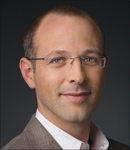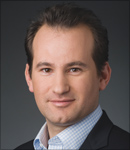I guess you could say that Opower is a different kind of company – a really different kind of company. While at first it seems that they’re just another “Smart Grid’ company. But after reading this interview, you will probably find – just as I did – that they take a very different approach to energy efficiency and demand response than most other suppliers in that realm. I recently had the opportunity to talk with the co-founders of Opower about the genesis of their company and its admirable accomplishments in the barely four years since its founding in 2007, as well as some interesting insights regarding how human behavior figures into achieving realistic, tangible goals for energy efficiency. – Ed.

Daniel Yates
CEO/Founder

Alex Laskey
President/Founder
EET&D : When I first heard about Opower, I didn’t immediately grasp the idea that it wasn’t going to easily fit into a conventional supplier category or classification. There are so many new CleanTech startups vying for a piece of the burgeoning Smart Grid market that are essentially variations, combinations and permutations of existing technologies, that it was quite a surprise to find something that was truly different. But let’s begin by explaining a bit about “that thing you do” for our readers.
Yates : Well, I suppose we really are different from a lot of other companies that are focused on the Smart Grid space. Our company was founded on the premise that it’s time to engage the 300 million Americans who are in the dark about their energy use. Alex and I combined our talents to actualize our belief in the power of information to improve people’s lives. Together, we envisioned a product focused on providing energy information to all, and created a company that would empower people to make smart decisions about conserving resources, reducing their energy consumption and helping to preserve our planet.
EET&D : One of the first things I noticed is that unlike a lot of the companies in the Smart Grid space, you really aren’t pushing a particular set of equipment or system architecture, and there is really nothing that requires new standards or standardization; that has implicitly dangerous cyber vulnerabilities; or that requires huge capital investments, is there?
Yates : No, there really isn’t. The Opower platform simply enables utilities to connect with their customers using existing communications channels: email, mail, SMS, phone and web. We can achieve a lot by making full use of what we already have.
EET&D : Eight of the ten largest utilities in the United States currently use your products to improve the effectiveness of their energy efficiency portfolios. How did you manage to accomplish that in such a short period of time?
Yates : We’ve been very fortunate in many ways, but like other enterprises that have successful products, it started with being focused and not trying to do too many things at once. We decided early on that sending information, not installing devices, was what we wanted to do, and we developed one communication channel at a time; we started with mail. As a consequence, we were able to build a highly effective customer engagement platform that today scales with ease across nearly 10 million households. We also took the time to consult our Chief Scientist, Robert Cialdini, and apply behavioral science research to our product design.
EET&D : Actually, I’ve reviewed a few of the reports on this topic and noticed that they identify some really interesting aspects of human behavior, especially as regards to what I’d call the inherently competitive spirit of most people. Can you elaborate on that a bit?
Laskey : Yes, that competitive spirit you refer to really is an important dimension of what drives people to do what they do, whether it’s energy efficiency or something else in their lives. As you have pointed out, it’s important to consider that the intent of these programs is to influence human behavior, much of which – when it comes to energy use – is as much a matter of habit as anything. There’s a passage from the 2009 Franklin Energy Report outlining behavioral change in residential energy use that I think sums things up rather well regarding the scientific foundation for this approach…
“Many of the ways in which consumers use energy at home are the result of behaviors like how and when we turn on and off lights and televisions in the rooms we use, how we set and adjust our thermostats, our practices in doing laundry and running our dishwasher, the frequency with which we replace furnace filters, even the length of the showers we take and whether we unplug our cell phone chargers when they are not in use. Impacting these habits is difficult for a number of reasons.
First it is important to recognize that electricity is an enabling product – consumers don’t turn on the television or the lamp to use energy, they want to be entertained and they want to see. Electricity is an intangible necessity that, as BC Hydro identifies, like toilet paper is a dissatisfier we take for granted until it is missing (BC Hydro 2008). This is the first challenge [of] any behavior change program; they must get people to notice and care about their energy use.
Secondly, behavior programs are largely focused on changing old habits. The benefit of habits, as Corinna Fischer [from The Federation of German Consumer Organizations in Germany] relates, is that habitual behavior is functional because it allows us to avoid expending the time and effort making decisions on issues that re-occur frequently and for which we have developed a means of addressing. The challenge is to break this cycle and protocol in order to get individuals to adopt more energy efficient habits.” (Franklin Energy Report; 2009)
And another report on human behavior prepared by Cialdini in 2004 (see excerpt following) helped to establish our belief that we could use behavioral science to accomplish what a lot of other companies have tried and failed to do with various combinations of technology and financial incentives. That report showed that we all make our decisions in significant part based on what others are doing. If you think about it, when you hear that a lot of other people are doing something, there’s an immediate curiosity in almost all of us that drives us to at least find out more. Tapping into this instinct is one of the keys to driving behavior change.
“The results from these studies clearly show the power and applicability of normative messages. Across our three-year set of studies, we have consistently found: a) that normative beliefs are correlated with behavior, and b) that normative messages can cause a change in behavior. The results from these studies are currently being written up for peer review and possible publication. In future research, we intend to continue our studies of normative social influence. One question that emerged from these studies concerns the process of social influence. Consistently across our studies, participants rate normative messages as the least effective and believe that they are not influenced by their perceptions of others. But our data show otherwise.” (“Understanding and Motivating Energy Conservation Via Social Norms”; 2004)
EET&D : How does your solution fit into the bigger picture for utilities investing heavily in Advanced Metering Infrastructure?
Laskey : The Smart Grid is great, and it makes our platform stronger. For example, with more timely data coming from smart meters, we can deploy features like giving folks email or SMS alerts telling them they’re headed for a high bill that month. People appreciate this information and feel more empowered as a result. By helping utilities roll out such services we help their customers clearly see the value of the smart meters.
EET&D : What do you think the success you’ve had with this concept say about the prospect of getting consumers to adopt energy efficiency as a lifestyle change?
Laskey : We estimate that around 85% of people utilities communicate with through our platform not only pay attention but take some kind of action. That’s quite an astounding figure, and it proves that the vast majority of the people don’t want to waste energy and are quite willing to make changes when given the right information. So large-scale behavior change is possible and it all starts with increased transparency and education.
EET&D : What about the tangible incentives associated with these programs; are they at all quantifiable?
Laskey : Yes, absolutely. These programs deliver an average of 1.5% to 3.5% in energy savings across the entire participant population. That may not sound like a big number, but it’s important to remember that we’re talking about the aggregate here – it includes people who may not open their mail or read the email. To put it in context, if everyone in the United States had access to better information about their energy, we could help people start saving enough energy to power more than three million homes, each year – that’s about as much as the amount of energy produced by the entire wind power industry. Several reputable scientists have looked at our data and verified that this is quite achievable.
EET&D : Can you put that into more specific terms relative to how much energy is actually being saved once the product is put into place at a given utility?
Yates : Depending on location, this means 150 to 300kWh in annual electricity savings per targeted household, or 10 to 15 Therms for gas customers. These are real savings for utility clients, and real dollars for consumers.
EET&D : Dan, would you like to take a shot at summing all of this up for our readers?
Yates : Sure. Opower is working with utilities around the world to help them transform the way they interact with their customers and in the process really make a huge leap forward in energy efficiency. We are a rapidly growing team of software engineers, product specialists, behavioral scientists, and efficiency advocates and are already engaging nearly 10 million households across the US. Helping ordinary people find easy ways to save on their energy bills is our passion; making an unprecedented impact on the health of our planet is our goal. And we hope that every one of your readers will join us in that quest!







